
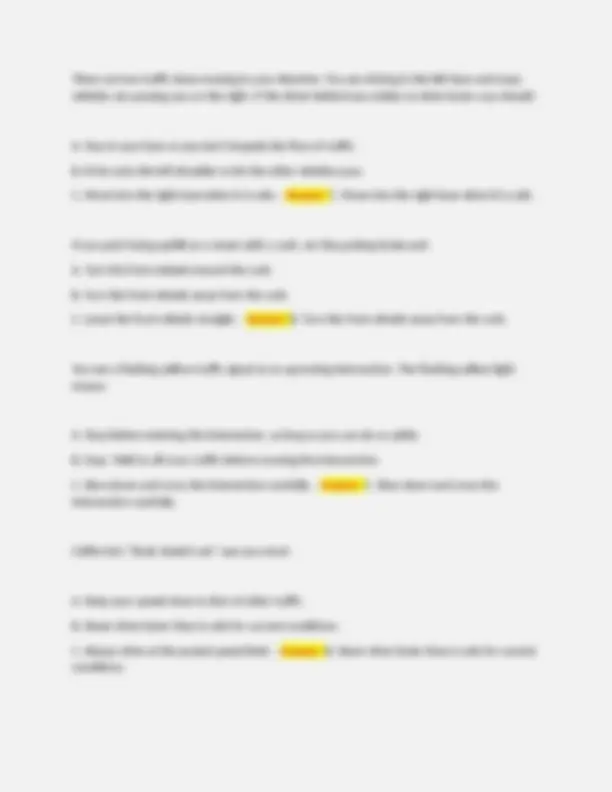
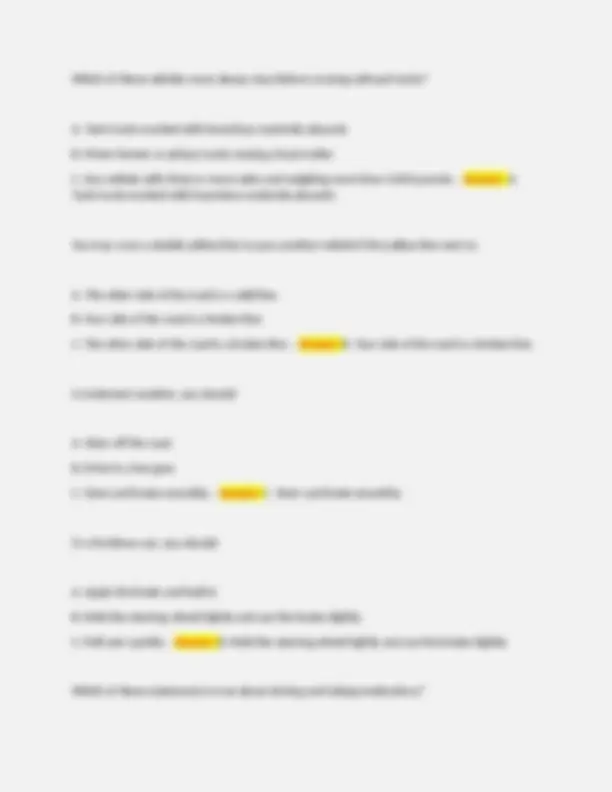
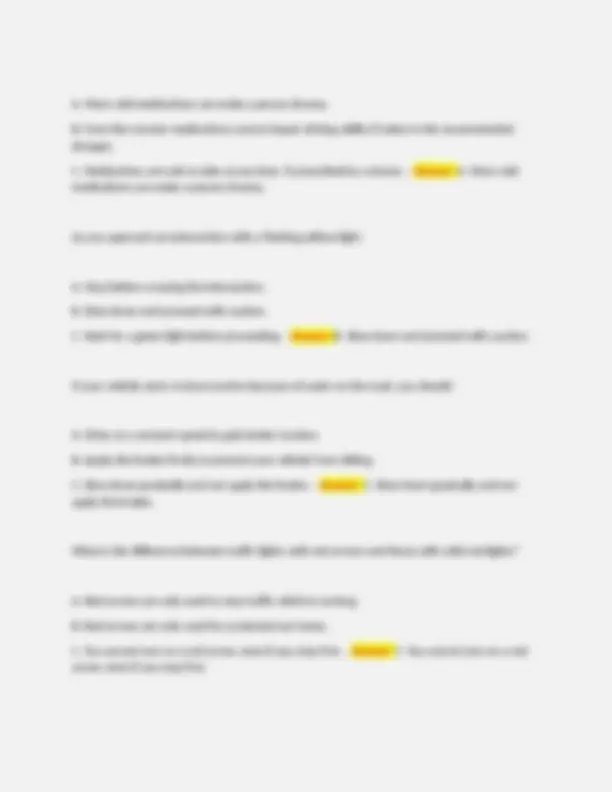
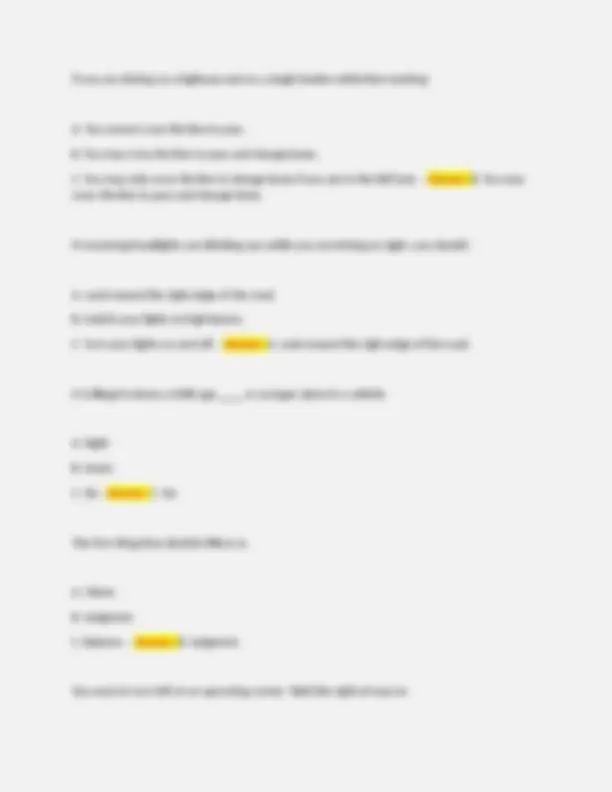
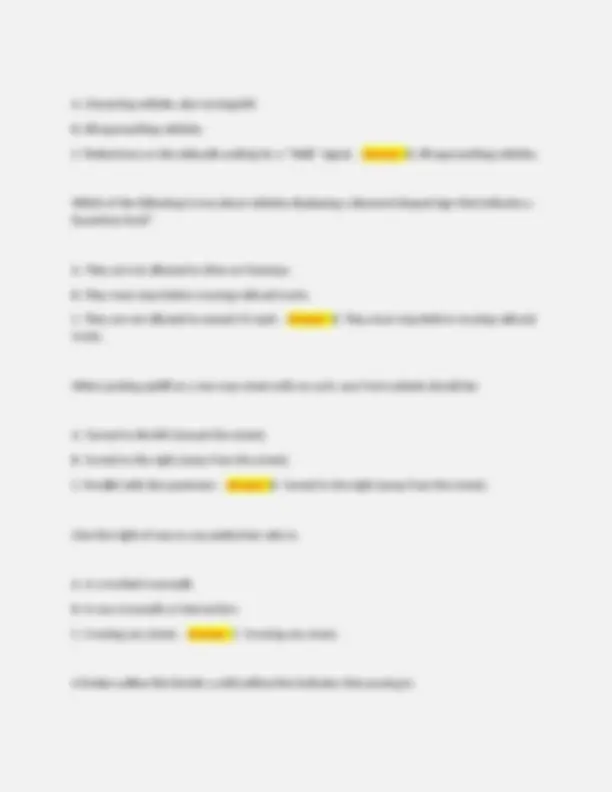
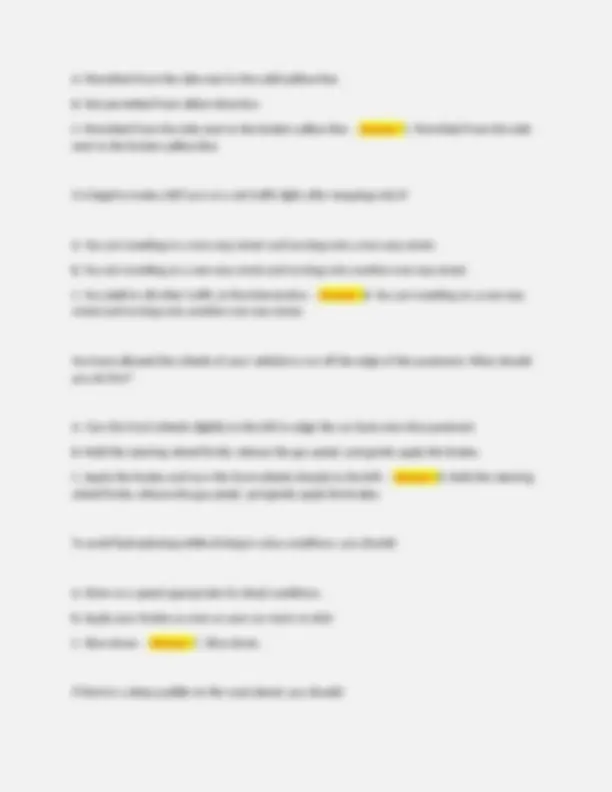
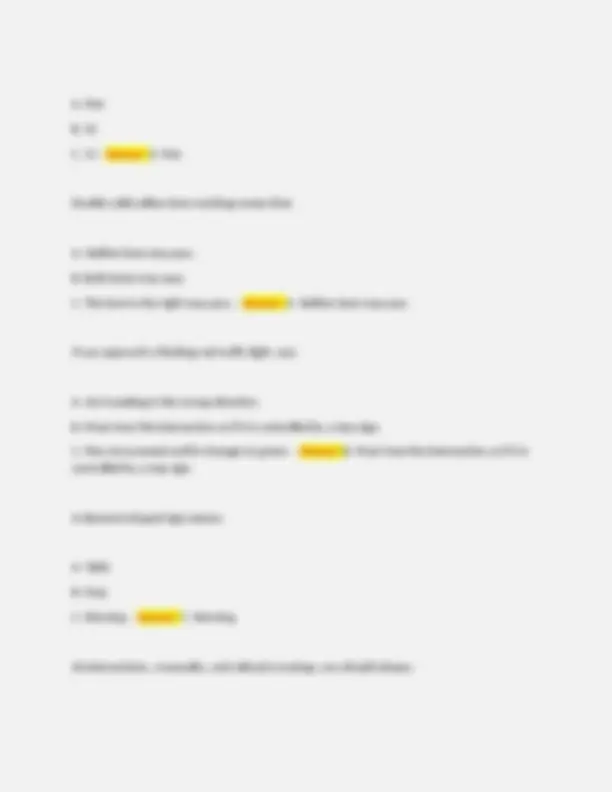
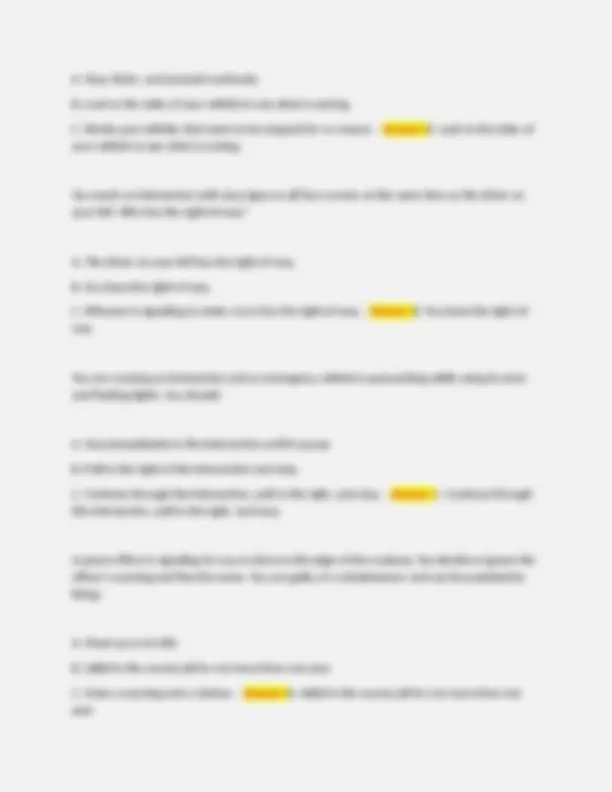
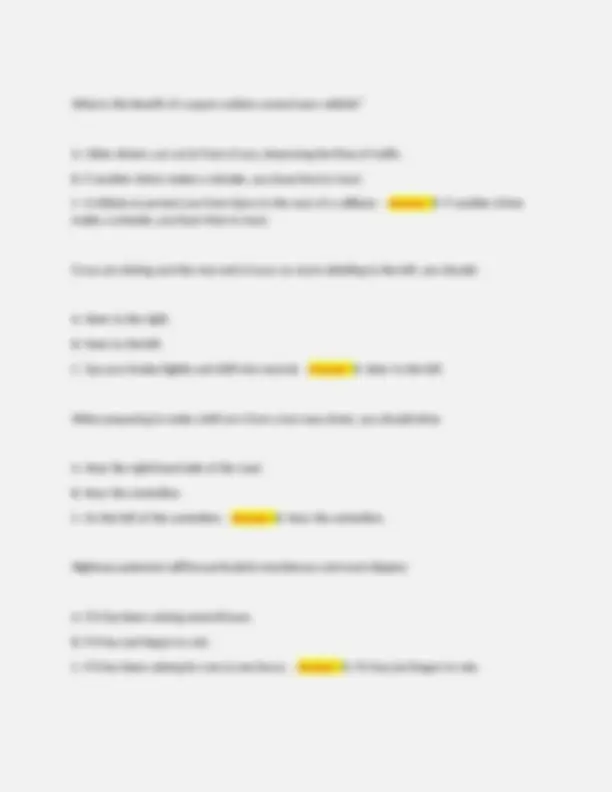


Study with the several resources on Docsity

Earn points by helping other students or get them with a premium plan


Prepare for your exams
Study with the several resources on Docsity

Earn points to download
Earn points by helping other students or get them with a premium plan
Community
Ask the community for help and clear up your study doubts
Discover the best universities in your country according to Docsity users
Free resources
Download our free guides on studying techniques, anxiety management strategies, and thesis advice from Docsity tutors
A series of key questions and answers related to the california dmv written test. It covers various driving scenarios, traffic laws, and safe driving practices. The questions address topics such as parking regulations, right-of-way rules, speed limits, and actions to take in inclement weather or emergency situations. This resource is designed to help individuals prepare for the california dmv written test by familiarizing them with the types of questions they may encounter and providing correct answers. It serves as a study aid for understanding california's driving laws and regulations, promoting safer driving habits and knowledge of traffic rules. The content is structured as a question-and-answer format, making it easy to review and test one's knowledge of california driving laws.
Typology: Exams
1 / 17

This page cannot be seen from the preview
Don't miss anything!










In which of the following scenarios should your wheels not be pointed straight ahead? A. When waiting to make a left turn at a traffic light. B. When parked on a hill or sloping driveway. C. When parked on the side of a level roadway where there is no curb. - Answer: B. When parked on a hill or sloping driveway. When driving in fog, rain, or snow, use: A. Low beams. B. High beams. C. Fog lights only. - Answer: A. Low beams. When being followed by a tailgater, which of the following will help you avoid being hit from behind? A. Merging into another lane B. Decreasing your following distance C. Changing lanes frequently - Answer: A. Merging into another lane A broken yellow centerline means that:
A. Passing is not permitted. B. Passing on the right is permitted when the way ahead is clear. C. Passing on the left is permitted when the way ahead is clear. - Answer: C. Passing on the left is permitted when the way ahead is clear. If you approach a traffic light with a red signal and a police officer directs you to go through the intersection without stopping, you should: A. Stop until the light turns green. B. Go through the intersection without stopping. C. Come to a complete stop before proceeding. - Answer: B. Go through the intersection without stopping. An orange and red triangular sign on a vehicle always means: A. The vehicle has the right-of-way. B. Slow-moving vehicle. C. Shoulder work ahead. - Answer: B. Slow-moving vehicle. A person may legally ride in the back of a pickup truck when: A. The sides of the pickup bed are at least 24 inches high. B. The back of the pickup is covered with a camper shell. C. In a secured seat and while using an approved safety belt. - Answer: C. In a secured seat and while using an approved safety belt.
Which of these vehicles must always stop before crossing railroad tracks? A. Tank trucks marked with hazardous materials placards. B. Motor homes or pickup trucks towing a boat trailer. C. Any vehicle with three or more axles and weighing more than 4,000 pounds. - Answer: A. Tank trucks marked with hazardous materials placards. You may cross a double yellow line to pass another vehicle if the yellow line next to: A. The other side of the road is a solid line. B. Your side of the road is a broken line. C. The other side of the road is a broken line. - Answer: B. Your side of the road is a broken line. In inclement weather, you should: A. Steer off the road. B. Drive in a low gear. C. Steer and brake smoothly. - Answer: C. Steer and brake smoothly. If a tire blows out, you should: A. Apply the brake and hold it. B. Hold the steering wheel tightly and use the brakes lightly. C. Pull over quickly. - Answer: B. Hold the steering wheel tightly and use the brakes lightly. Which of these statements is true about driving and taking medications?
A. Most cold medications can make a person drowsy. B. Over-the-counter medications cannot impair driving ability if taken in the recommended dosages. C. Medications are safe to take at any time, if prescribed by a doctor. - Answer: A. Most cold medications can make a person drowsy. As you approach an intersection with a flashing yellow light: A. Stop before crossing the intersection. B. Slow down and proceed with caution. C. Wait for a green light before proceeding. - Answer: B. Slow down and proceed with caution. If your vehicle starts to lose traction because of water on the road, you should: A. Drive at a constant speed to gain better traction. B. Apply the brakes firmly to prevent your vehicle from sliding. C. Slow down gradually and not apply the brakes. - Answer: C. Slow down gradually and not apply the brakes. What is the difference between traffic lights with red arrows and those with solid red lights? A. Red arrows are only used to stop traffic which is turning. B. Red arrows are only used for protected turn lanes. C. You cannot turn on a red arrow, even if you stop first. - Answer: C. You cannot turn on a red arrow, even if you stop first.
A flashing yellow traffic signal at an intersection means: A. You should treat the signal like a stop sign. B. Stop. Yield to all cross traffic before crossing in the intersection. C. Slow down and be alert at the upcoming intersection. - Answer: C. Slow down and be alert at the upcoming intersection. At an uncontrolled intersection where you cannot see cross traffic until you are just about to enter the intersection, the speed limit is: A. 15 mph. B. 25 mph. C. 20 mph. - Answer: A. 15 mph. The speed limit in any alley is: A. 20 mph. B. 15 mph. C. 25 mph. - Answer: B. 15 mph. Increase your following distance when driving behind a large vehicle: A. To better see around the sides of the vehicle. B. Because other drivers tend to pull behind large vehicles before trying to pass them. C. Because following too closely will get you caught in the vehicle's slipstream. - Answer: A. To better see around the sides of the vehicle.
If you are driving on a highway next to a single broken white line marking: A. You cannot cross the line to pass. B. You may cross the line to pass and change lanes. C. You may only cross the line to change lanes if you are in the left lane. - Answer: B. You may cross the line to pass and change lanes. If oncoming headlights are blinding you while you are driving at night, you should: A. Look toward the right edge of the road. B. Switch your lights to high beams. C. Turn your lights on and off. - Answer: A. Look toward the right edge of the road. It is illegal to leave a child age ____ or younger alone in a vehicle A. Eight B. Seven C. Six - Answer: C. Six The first thing that alcohol effects is: A. Vision. B. Judgment. C. Balance. - Answer: B. Judgment. You want to turn left at an upcoming corner. Yield the right-of-way to:
A. Permitted from the side next to the solid yellow line. B. Not permitted from either direction. C. Permitted from the side next to the broken yellow line. - Answer: C. Permitted from the side next to the broken yellow line. It is legal to make a left turn at a red traffic light after stopping only if: A. You are traveling on a two-way street and turning onto a two-way street. B. You are traveling on a one-way street and turning onto another one-way street. C. You yield to all other traffic at the intersection. - Answer: B. You are traveling on a one-way street and turning onto another one-way street. You have allowed the wheels of your vehicle to run off the edge of the pavement. What should you do first? A. Turn the front wheels slightly to the left to edge the car back onto the pavement. B. Hold the steering wheel firmly, release the gas pedal, and gently apply the brakes. C. Apply the brakes and turn the front wheels sharply to the left. - Answer: B. Hold the steering wheel firmly, release the gas pedal, and gently apply the brakes. To avoid hydroplaning while driving in rainy conditions, you should: A. Drive at a speed appropriate for ideal conditions. B. Apply your brakes as soon as your car starts to skid. C. Slow down. - Answer: C. Slow down. If there is a deep puddle on the road ahead, you should:
A. Maintain the posted speed to make it through the water. B. Avoid the puddle if possible. C. Shift into neutral as you drive through the water. - Answer: B. Avoid the puddle if possible. At an intersection with a yield sign, you: A. Must yield the right-of-way to cross traffic that is close enough to cause conflict. B. Must yield to vehicles only on your right. C. Should slow down but never stop. - Answer: A. Must yield the right-of-way to cross traffic that is close enough to cause conflict. Blue traffic signs offer information on: A. Motorist services. B. Construction and maintenance. C. Mileage information, such as distances to specific locations. - Answer: A. Motorist services. A solid yellow line next to a broken yellow line means that vehicles: A. Driving in both directions may pass. B. Next to the broken line may pass. C. Next to the solid line may pass. - Answer: B. Next to the broken line may pass. When parking your vehicle parallel to the curb on a level street:
A. Five B. 10 C. 15 - Answer: A. Five Double solid yellow lane markings mean that: A. Neither lane may pass. B. Both lanes may pass. C. The lane to the right may pass. - Answer: A. Neither lane may pass. If you approach a flashing red traffic light, you: A. Are traveling in the wrong direction. B. Must treat the intersection as if it is controlled by a stop sign. C. May not proceed until it changes to green. - Answer: B. Must treat the intersection as if it is controlled by a stop sign. A diamond-shaped sign means: A. Yield. B. Stop. C. Warning. - Answer: C. Warning. At intersections, crosswalks, and railroad crossings, you should always:
A. Stop, listen, and proceed cautiously. B. Look to the sides of your vehicle to see what is coming. C. Slowly pass vehicles that seem to be stopped for no reason. - Answer: B. Look to the sides of your vehicle to see what is coming. You reach an intersection with stop signs on all four corners at the same time as the driver on your left. Who has the right-of-way? A. The driver on your left has the right-of-way. B. You have the right-of-way. C. Whoever is signaling to make a turn has the right-of-way. - Answer: B. You have the right-of- way. You are crossing an intersection and an emergency vehicle is approaching while using its siren and flashing lights. You should: A. Stop immediately in the intersection until it passes. B. Pull to the right of the intersection and stop. C. Continue through the intersection, pull to the right, and stop. - Answer: C. Continue through the intersection, pull to the right, and stop. A peace officer is signaling for you to drive to the edge of the roadway. You decide to ignore the officer's warning and flee the scene. You are guilty of a misdemeanor and can be punished by being: A. Fined up to $1,000. B. Jailed in the county jail for not more than one year. C. Given a warning and a citation. - Answer: B. Jailed in the county jail for not more than one year.
If you are about to be hit from the rear, you should consider each of the following, except for: A. Applying your brakes. B. Letting go of the steering wheel. C. Pressing your head firmly against the head restraint. - Answer: B. Letting go of the steering wheel. A white painted curb indicates a: A. Loading zone for freight or passengers. B. Loading zone for passengers or mail only. C. Loading zone for freight only. - Answer: B. Loading zone for passengers or mail only. You should signal at least how many feet before you turn? A. 50 B. 75 C. 100 - Answer: C. 100 If you are being passed in a no passing zone, you should: A. Pull off the road. B. Maintain your speed and position. C. Slow down and let the other driver safely return to the drive lane. - Answer: C. Slow down and let the other driver safely return to the drive lane. When entering an interstate highway, you should:
A. Stop, check for cars, and enter when safe. B. Check for cars and reduce your speed to 25 mph before entering the traffic lane. C. Check for cars, increase your speed to match the flow of traffic, and merge when the way is clear. - Answer: C. Check for cars, increase your speed to match the flow of traffic, and merge when the way is clear. When a bicyclist is making a left turn: A. They may use the left lane. B. They may cut through all lanes. C. They may wait on the side of the road. - Answer: A. They may use the left lane.